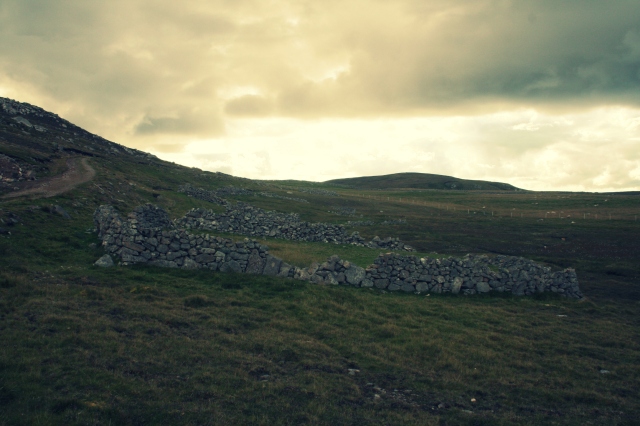Last year my colleague from work was very kind to give me some Shetland Kale seeds she kept that season. I was very excited about the prospect of growing an old Shetland crop and particularly because it would be grown from a heritage variety seed that was lovingly nurtured and saved unlike mass-produced commercial hybrid seeds.
When looking for more information about Kale I came across this some interesting information at Slow Food UK:
Shetland Cabbage
What are my special features?
Much variation can be found in this cabbage/kale (Brassica oleracea L) and the heart is a lot more open than modern cabbage varieties. The cabbage has a characteristic peppery taste and is traditionally cooked in a mutton stew.
What is my history?
Shetland Cabbage/Kale is the oldest known Scottish local vegetable variety and has been grown on the Shetland Islands since at least the 17th Century. Specific origin details of this landraceis unknown. The outer or dropped leaves were often used as winter feed for cattle and sheep.
Due to the extreme weather conditions on the Islands cabbage seeds were traditionally planted in plantie crubs, a small circular stone-walled enclosure. The cabbage seedlings were then transplanted into larger yards also often with stone walls. These structures can still be seen all over the islands despite many being in ruins.
Why am I forgotten?
In the last 30 years, there has been a steep decline in Shetland Cabbage and competition within other well-known supermarket varieties is further problematic for such traditional varieties.
Don’t lose me… cook me!
Kale was immortalised in the Shetland poem “Auld Maunsie’s Cro” by Basil R. Anderson:
‘Auld Maunsie biggit him a Cro
Ta grow him kale fir mutton bro
Fir Maunsie never tocht him hale,
Withoot sheeps shanks an kogs o’kale’
I found out that seed of Shetland Cabbage is not sold commercially and the survival of this, and other, landraces is entirely dependent on growers saved seed. Find out more here.
I’m planning to try keep some seed this year if the plants succeed so if anyone is interested in giving it a go please let me know and I’ll get you some seed.
Photo No.3: Silent witnesses to intensive crofting in the past – plantie crubs and kale yards in Culswick. To see this magic place and enjoy a fine walk to Culswick Broch check Walk Shetland.



That’s really interesting, I’m a big fan of brassicas, such a nutritious plant family! I’m especially keen on growing heritage, open pollinated varieties, so I’d love some seed if you have some spare when the time comes 🙂
Brilliant, no problem – let’s keep in touch and I’ll keep you posted how I get on. Misa
Good article on such a good plant. Culswick does indeed have a lot of old planticrubs and in the past was renowned for the availability of kale plants and supplied many folk with kale to set their yards with in the voar (spring). We used to feed kye & sheep and ourselves of course but now feed silage for winter keep.
Local rumour has it that this was the only thing the Shetland whalers stationed in South Georgia could get to grow on the thin, poor soil in that inhospitable climate. It’s tough stuff!
That sounds really interesting Jon, it would be worth finding out…
Perhaps we could cover Shetland whalers in some of the future issues of 60 North – would you be interested to write about it?
Hi Misa, I was researching Sheltand kale and came across your article. I am studying Herbology at the Botanic gardens in Edinburgh and as part of the course we have to nurture a herb bed. I have chosen to base mine on traditional plants of Scotland, mostly crops and herbs used in Croting. I am learning so much about wonderful Scottish plants and I think the Shetland kale MUST go pride of place in the bed! I was wondering how successful your growing and seed collecting was last year and if you would have a seed or two to spare? I think it would be lovely to continue the seed sharing year after year and help to bring these wonderful plants back to people’s awareness…I’ve just signed up for your blog so I look forward to reading more about your life up there on the beautiful isle. Hannah 🙂
Hi Hannah, thank you for you lovely comments and I’m really excited to hear that you have chosen traditional plants and herbs used in crofting for your project. I completely forgot that brassicas are biennial plant so the seeds will only be ready (hopefully) after this summer and of course you are welcome to them. However I will try to get hold of seeds for your from my friend who has a croft. Please can you email me your postal address? My email address is misa.hay@googlemail.com
Hi,
I don’t know if this is the proper way to start some chatting, but oh well. I was just wondering if you had any idea of how to get Shetland Kale, Hebridean Rye, and Shetland Black Oat seed anywhere? Anyways, I hope you are doing far better then you can physically stand.
Sean
Hello from northern west michigan…our weather would be well suited to grow the Kale, would love some seeds to try it and build a planticrub to grow it in.
All of you may enjoy Ann Cleeves Shetland series of books that take place all over the Shetland Isles…they are a mystery series very cleverly written, full of Scottish Lore.
Pingback: To Plant a Garden Is to Believe in Tomorrow | My Shetland Garden